![]()
![]()
![]()
Use LEFT and RIGHT arrow keys to navigate between flashcards;
Use UP and DOWN arrow keys to flip the card;
H to show hint;
A reads text to speech;
45 Cards in this Set
- Front
- Back
- 3rd side (hint)
|
CELL MEMBRANE STRUCTURE |
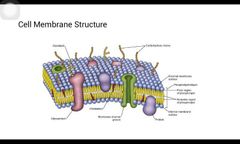
|
|
|
|
STRUCTURAL LIPIDS IN MEMBRANE |
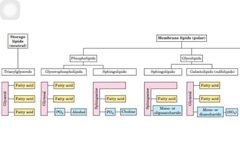
|
|
|
|
PHOSPOLHOLIPID |
polar, ionic compounds composed of an alcohol that is attached by a phosphodiester bridge to either diacylglycerol or sphingosine. |
|
|
|
Structure of Phospholipids |
-There are two classes of phospholipids: those that have glycerol as a backbone and those that contain sphingosine.
-Both classes are found as structural components of membranes, and both play a role in the generation of lipid-signaling molecules. |
|
|
|
Glycerophospholipids |
-phospholipids that contain glycerol as a backbone.
-Glycerophospholipids constitute the major class of phospholipids.
-All contain (or are derivatives of) phosphatidic acid (diacylglycerol with a phosphate group on the third carbon)
- Glycerophospholipids are formed from phosphatidic acid (PA) and an alcohol: The phosphate group on PA can be esterified to another compound containing an alcohol group.
|
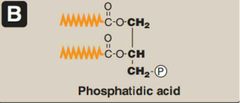
|
|
|
Sphingophospholipids |
phospholipids that contain sphingosine as a backbone. |
|
|
|
NAME OF GLYCEROPHOSPHOLIPID |
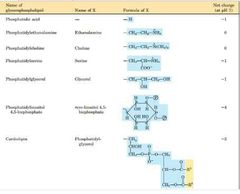
|
|
|
|
PLASMALOGEN |
When the fatty acid at carbon 1 of a glycerophospholipid is replaced by an unsaturated alkyl group attached by an ether (rather than by an ester) linkage to the core glycerol molecule, a plasmalogen is produced. |
|
|
|
CARDIOLIPIN |
-two molecules of PA esterified through their phosphate groups to an additional molecule of glycerol. |
|
|
|
Platelet-activating factor (PAF) |
Is synthesized and released by a variety of cell types. It binds to surface receptors, triggering potent thrombotic and acute inflammatory events. |
|
|
|
SPHINGOLIPIDS |
Composed of one molecule of the long-chain amino alcohol sphingosine (also called 4-sphingenine) or one of its derivatives,one molecule of a long-chain fatty acid, and a polar head group that is joined by a glycosidic linkage in some cases and by a phosphodiester in others. |

|
|
|
3 SUBCLASSES OF SPHINGOLIPIDS (DERIVATIVES OF CERAMIDE) |
1.sphingomyelins 2.neutral (uncharged) glycolipids 3.gangliosides |
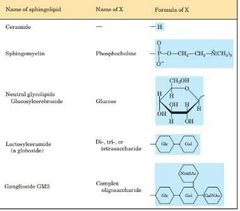
|
|
|
Sphingolipids at Cell Surfaces |
Sites of Biological Recognition |
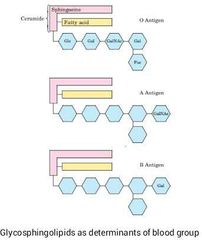
e.g |
|
|
SPHINGOMYELIN |
-The backbone is the amino alcohol sphingosine, rather than glycerol. -An important constituent of the myelin of nerve fibers. |
|
|
|
The specificities of Phospholipases |
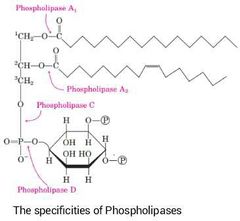
|
|
|
|
It is where phospholipids and sphingolipids are degraded? |
Lysosome |
|
|
|
Diseases associated with a defect in Sphingolipids degradation |
1. Tay-Sachs Disease 2. Sandhoff Disease 3. Gaucher Disease 4. Metachromatic Leukodystrophy 5. Krabbe Disease 6. Farber Disease 7. Niemann-Pick Disease (A+B) 8. Fabry Disease (x-linked) 9. GM1 Gangliosidosis |
|
|
|
Tay-Sachs Disease |

|
|
|
|
Sandhoff Disease |

|
|
|
|
Gaucher Disease |

|
|
|
|
Metachromatic Leukodystrophy |

|
|
|
|
Krabbe Disease
|

|
|
|
|
Farber Disease |

|
|
|
|
Niemann-Pick Disease (A+B)
|

|
|
|
|
Fabry Disease (x-linked) |

|
|
|
|
GM1 Gangliosidosis |

|
|
|
|
Eicosanoids: Prostaglandins and Related Compounds |
-areparacrine hormones -They are known to be involved: 1.Reproductive function 2.Inflammation 3.Fever 4.Pain associated with injury or disease 5.Formation of blood clots 6.Regulation of blood pressure 7.Gastric acid secretion |
|
|
|
THROMBOXANE A2 |
Produced by COX-1 in activated platelets. It promotes adherence and aggregation of circulating platelets, and contraction of vascular smooth muscle, thus promoting formation of blood clots (thrombi) |
|
|
|
PROSTACYCLIN (PGI2) |
-produced by COX-2 in vascular endothelial cells -Inhibits platelet aggregation and stimulates vasodilation, and so impedes thrombogenesis. |
|
|
|
LEUKOTRIENES |
-Found first in Leukocytes, are mediators of allergic response and inflammation. -Overproduction of leukotrienes causes asthmatic attacks, and leukotriene synthesis is one target of antiasthmatic drugs such as prednisone. |
|
|
|
STEROID HORMONES |
-Carry messages bet. tissues
- Oxidized derivatives of sterols -They have the sterol nucleus but lack the alkyl chain attached to ring D of cholesterol, and they are more polar than cholesterol. - Move through the bloodstream (on protein carriers) from their site of production to target tissues, where they enter cells, bind to highly specific receptor proteins in the nucleus, and trigger changes in gene expression and metabolism. |
|
|
|
VIT. A & D |
Hormone precursors |
|
|
|
FAT-SOLUBLE VITAMINS |
Soluble in nonpolar organic solvents |
|
|
|
WATER-SOLUBLE VITAMINS |
Could be extracted from foods with aqueous solvents. |
|
|
|
VITAMIN D3 |
-AKA CHOLECALCIFEROL
-Normally formed in the skin from 7-dehydrocholesterol in a photochemical reaction driven by the UV component of sunlight. - Not itself biologically active, but it is converted by enzymes in the liver and kidney to 1,25-dihydroxycholecalciferol, a hormone that regulates calcium uptake in the intestine and calcium levels in kidney and bone. |
|
|
|
VIT. D2 |
-AKA ERGOCALCIFEROL - A commercial product formed by UV irradiation of the ergosterol of yeast. Vitamin D2 is structurally similar to slight modification to the side chain attached to the sterol D ring. |
|
|
|
Oxidation-Reduction Cofactors |
Vitamins E and K and the Lipid Quinones |
|
|
|
VIT. A |
-AKA RETINOL -Has various functions (as a hormone and as the visual pigment of the vertebrate) |
|
|
|
VIT. E |
-AKA TOCOPHEROL
-contain a substituted aromatic ring and a long isoprenoid side chain
-They act as biological antioxidants. - The aromatic ring reacts with and destroys the most reactive forms of oxygen radicals and other free radicals, protecting unsaturated fatty acids from oxidation and preventing oxidative damage to membrane lipids, which can cause cell fragility. |
|
|
|
VIT. K |
-Undergoes a cycle of oxidation and reduction during the formation of active prothrombin, a blood plasma protein essential in blood clot formation.
-Vitamin K1 is also known as PHYLLOQUINONE -Vitamin K2 is also known as MENAQUINONE |
|
|
|
LIPID EXTRACTION |
-Require Organic Solvents
- Neutral lipids (triacylglycerols, waxes, pigments) are readily extracted from tissues with ethyl ether, chloroform, or benzene, solvents that do not permit lipid clustering driven by hydrophobic interactions. |
|
|
|
Polar organic solvents (ethanol or methanol) |
which reduce the hydrophobic interactions among lipidmolecules while also weakening the hydrogen bonds and electrostatic interactions that bind membrane lipids tomembrane proteins. |
|
|
|
COMMONLY USED EXTRACTANT |
a mixture of chloroform, methanol, and water, initially in volume proportions 1:2:0:8 that are miscible, producing a single phase. |
|
|
|
Adsorption Chromatography |
-Separates Lipids of Different Polarity |
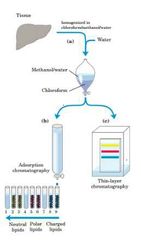
|
|
|
Gas-Liquid Chromatography |
-Resolves Mixtures of Volatile Lipid Derivatives
- separates volatile components of a mixture according to their relative tendencies to dissolve in the inert material packed in the chromatography column and to volatilize and move through the column, carried by a current of an inert gas such as helium. |
|

